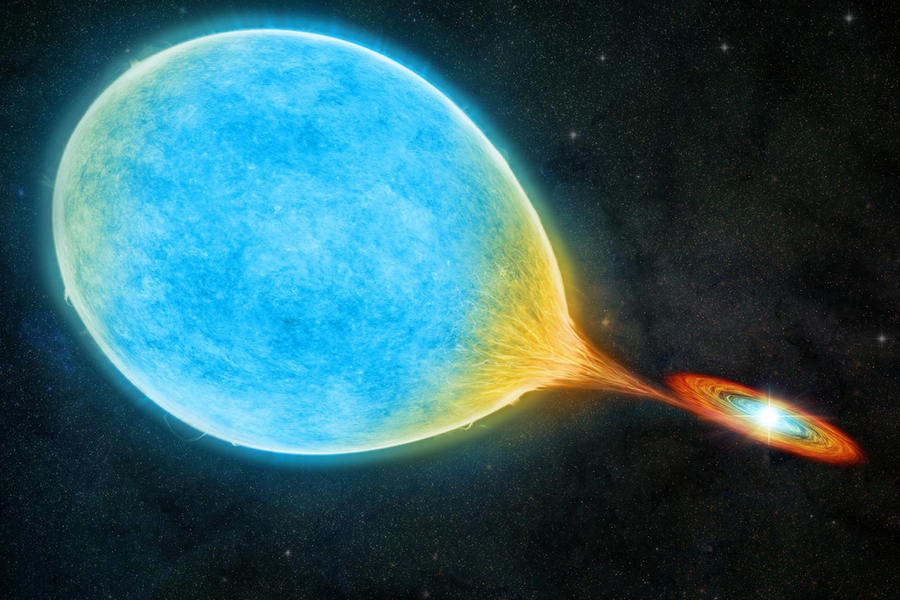The Turning of the Stellar Seasons
by Adam Hadhazy
Research Highlights from Kavli Astrophysics Institutes

The Author
With fall in full swing in many seasonal places in the Northern Hemisphere, the fierce verdancy of summer foliage has given way to crimsons and ochres. A changing of hues similarly happens for many kinds of stars as they, too, advance into the autumnal stages of stellar life. Our sun is a prime example. Classified as a G star, it presently appears white in the visible spectrum that our eyes see. The sun has blazed forth in this way for more than four billion years, as seemingly potent and steady as those green leaves soaking up that very sunlight for the last few months. But in another five billion years or so, the sun will likewise start Octoberizing. As is the way for all stars with about half the sun's mass, up through about five solar masses, the sun will evolve into a so-called red giant. The steady eons-long supply of fresh hydrogen to fuse into helium will have finally run low in the sun's core, and the aging star's outer layers will balloon outward, cooling and reddening. The sun's color-changing will not end there. Another billion years or so later, the sun will have worked through all its available nuclear fuel, shed its outer layers entirely into space, and at last come to its winter. Appropriately enough, this along-in-years remnant of the sun will be a gleaming white in appearance, a "white dwarf" in astronomer parlance, and evocative of a snow-locked barrenness. Scientists can predict these eventualities with extremely high confidence, thanks to our observations of countless other stars going through these stages and our deep theoretical understanding of the hows and whys. The scientific process thus enables us to know why the innumerable leaves above our heads change as they do, as well as also—though much farther above our heads—the innumerable stars.
Directly sampled asteroid's composition is unlike that of Earth-fallen meteorites
A detailed analysis of samples brought back to Earth of the asteroid Ryugu have revealed the asteroid has different elemental abundances than all other space rocks known to have crashed onto our planet as meteorites. The findings suggest that these other meteorites have been contaminated by their fall through Earth's atmosphere. By the same token, the research suggests that Ryugu's pristine samples—which were delivered to Earth in a sealed vessel—are reflective of actual, eons-old, original elemental abundances out in the Solar System. The analysis of the special Ryugu samples was done nondestructively through the use of muon beams from a particle accelerator in Japan. Members of the Kavli Institute for the Physics and Mathematics of the Universe at the University of Tokyo contributed to the study effort.

Getting down to low, low levels to catch dark matter
In a Research Highlight, Noah Kurinsky—a physicist at the Kavli Institute for Particle Astrophysics and Cosmology (KIPAC) at Stanford University—explains why the search for hypothetical dark matter particles at extremely low mass/energy scales is so experimentally challenging. Given the higher mass/energy scales where dark matter has been ruled out, researchers are now looking for superlight particles. These particles would only possess the equivalent oomph of low-energy photons, specifically that of long-wavelength infrared light. This weakness poses an inherent problem because photons at that energy level are continually produced by all objects at room temperature. The solution? Building dark matter detectors with far greater sensitivity than typical infrared detectors and operating the detectors at near-absolute-zero temperatures to eliminate the background infrared radiation signal from the environment. Neither of those needs is easily met, however, and comes with other difficulties, as the Highlight further explains. That said, KIPAC researchers and their colleagues understand the challenges well, and are continuing to make advances to meet them.
Shortest orbiting stellar pair discovered
Astrophysical records are made to be broken! A new study—led by researchers at MIT's Kavli Institute for Astrophysics and Space Research—has just such a report. The study documents the shortest-orbiting stellar pair ever observed, where the two stars complete an orbit around each other in a whizzy 51 minutes. The stellar pair is a so-called cataclysmic variable, where one star is a typical star like the Sun but the other is the remnant of a sunlike star called a white dwarf. The researchers ran simulations predicting how the stars' orbit will evolve further. Compellingly, these predictions ended up matching separate predictions put out decades ago about how cataclysmic variables will transition to ultrashort orbital periods before drifting farther apart. The agreeing estimates prognosticate that the stars will reach their closest point in an 18-minute orbit in approximately 70 million years.

The amazing story of Subrahmanyan Chandrasekhar
Daniel Holz and Robert Wald, both affiliated with the Kavli Institute for Cosmological Physics at the University of Chicago, were guests on a recent episode of the Big Brains podcast supported by the university. Holz and Wald discuss the remarkable story of how Subrahmanyan Chandrasekhar, who at just 19 years old made a stunning breakthrough in the understanding of the objects that came to be called black holes. A young immigrant from India, "Chandra," as Subrahmanyan went by, provocatively proposed to the British scientific establishment in 1935 that these radical objects must exist. Chandra proved to be right, eventually winning a Nobel Prize for his insights into stellar evolution, and he even had a space telescope named after him. Wald came to UChicago in 1974 as a postdoc and met often with Chandra, who had become a professor there, and Holz also overlapped with Chandra as a grad student. Both researchers have followed in Chandra's footsteps and become experts on black holes.
Born under pure skies and destined to be an astrophysicist
KIPAC's Enrique López Rodríguez is the "star" of a profile appearing in Stanford University's Stanford Report. López Rodríguez was born in the Canary Islands, a remote archipelago famous as one of the best places in the world to conduct astronomy thanks to its pristine skies. At KIPAC, his research is galactic in nature, focusing on the roles of magnetic fields in the formation and evolution of galaxies, including the growth and activity of the supermassive black holes found in many galaxies' cores. The profile relates how López Rodríguez went from struggling through grade school and living with his grandmother to being a scientist at a prestigious institution who mentors previously incarcerated students.